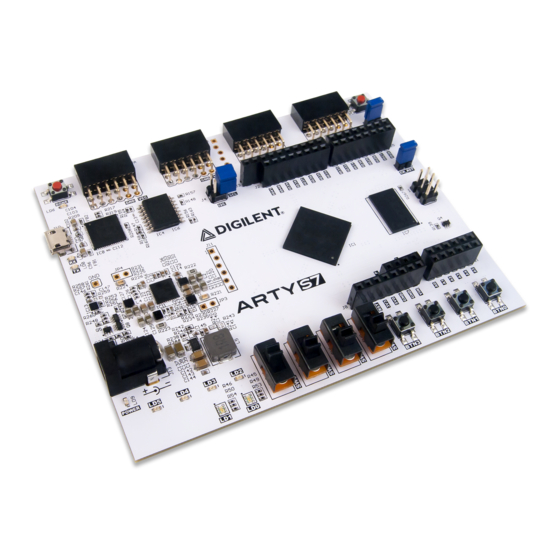Digilent Arty S7 Справочное руководство - Страница 10
Просмотреть онлайн или скачать pdf Справочное руководство для Материнская плата Digilent Arty S7. Digilent Arty S7 14 страниц.

(https://reference.digilentinc.com/_detail/reference/programmable-logic/arty-s7/arty-s7-gpio.png?id=reference%3Aprogrammable-logic%3Aarty-s7%3Areference-manual)
The four individual high-efficiency LEDs are anode-connected to the FPGA via 330-ohm resistors, so they will turn on when a logic high voltage is applied to their respective I/O pin.
Additional LEDs that are not user-accessible indicate power-on, FPGA programming status, and USB and Ethernet port status.
7.1 Tri-Color LEDs
The Arty S7 board contains two tri-color LEDs. Each tri-color LED () has three input signals that drive the cathodes of three smaller internal LEDs: one red, one blue, and one green.
Driving the signal corresponding to one of these colors high will illuminate the internal LED (). The input signals are driven by the FPGA through a transistor, which inverts the
signals. Therefore, to light up the tri-color LED (), the corresponding signals need to be driven high. The tri-color LED () will emit a color dependent on the combination of internal
LEDs that are currently being illuminated. For example, if the red and blue signals are driven high and green is driven low, the tri-color LED () will emit a purple color.
Note: Digilent strongly recommends the use of pulse-width modulation (PWM) when driving the tri-color LEDs. Driving any of the inputs to a steady logic '1' will result in the LED ()
being illuminated at an uncomfortably bright level. You can avoid this by ensuring that none of the tri-color signals are driven with more than a 50% duty cycle. Using PWM also
greatly expands the potential color palette of the tri-color LED (). Individually adjusting the duty cycle of each color between 50% and 0% causes the different colors to be illuminated
at different intensities, allowing virtually any color to be displayed.
8 Pmod Connectors
Pmod connectors are 2×6, right-angle, 100-mil spaced female connectors that mate with standard 2×6 pin headers. Each 12-pin Pmod connector provides two 3.3V VCC () signals
(pins 6 and 12), two Ground signals (pins 5 and 11), and eight logic signals, as shown in Figure 8.1. The VCC () and Ground pins can deliver up to 1A of current, but care must be
taken not to exceed any of the power budgets of the onboard regulators or the external power supply (these are described in the "Power supplies" section).
Digilent produces a large collection of Pmod accessory boards that can attach to the Pmod expansion connectors to add ready-made functions like A/D's, D/A's, motor drivers,
sensors, and other functions. See
The Arty S7 has four Pmod connectors, some of which behave differently than others. Each Pmod connector falls into one of two categories: standard or high-speed. Also, some
Pmod connectors share their connections with the inner rows of the shield connector, and should not be used at the same time as a shield that requires those pins. Table 8.1 specifies
which category each Pmod falls into, whether it shares any pins with the shield connector, and also lists the FPGA pins they are connected to. The following sections describe the
different types of Pmods.
(https://reference.digilentinc.com/_detail/basys3-pmod_connector.png?id=reference%3Aprogrammable-logic%3Aarty-s7%3Areference-manual)
Pmod Type
Shared pins
Pin 1
Pin 2
Pin 3
Pin 4
Pin 7
Pin 8
www.digilentinc.com
(http://www.digilentinc.com)
Pmod JA
High-Speed
–
L17
L18
M14
N14
M16
M17
for more information.
Pmod JB
High-Speed
–
P17
P18
R18
T18
P14
P15
Figure 8.1. Pmod connector.
Pmod JC
Pmod JD
Standard
Standard
IO34-IO41
IO26-IO33
U15
V15
V16
U12
U17
V13
U18
T12
U16
T13
P13
R11
Figure 7.1. Arty S7 GPIO ().
